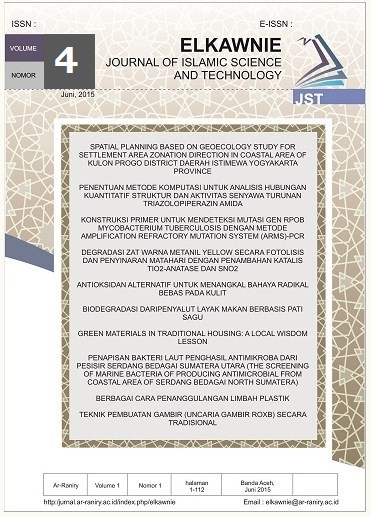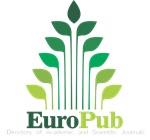Isolasi dan Karakterisasi Nanokistral Selulosa dari Tandan Sawit (Elaeis Guineensis Jack)
DOI:
https://doi.org/10.22373/ekw.v4i1.2877Keywords:
Tandan Kosong Sawit, Nanokristal selulosa, Hidrolisis asam.Abstract
Penelitian ini mengenai analisis nanokristal selulosa dilakukan secara laboratorium. Penelitian ini dilakukan untuk mendapatkan informasi karakterisasi nanokristal selulosa hasil isolasi dari tandan kosong sawit. Tahap awal yaitu isolasi α-selulosa dari tandan kosong sawit (TKS) melalui proses dilignifikasi dengan menggunakan HNO3 3,5 dan NaNO2, kemudian peoses pulping dengan NaOH 17%, dan pemutihan dengan H2O2 10%. Tahap selanjutnya yaitu isolasi Nanokristal selulosa dari α-selulosa dilakukan dengan hidrolisis asam, yaitu dengan menggunakan asam sulfat 48,84%, yang kemudian didialisis hingga diperoleh nanokristal selulosa. Nanokristal selulosa yang dihasilkan dikarakterisasi gugus fungsinya dengan menggunakan FT-IR, dan kemudian analisis morfologi dan ukuran dengan menggunakan TEM. Ukuran nanokristal yang dihasilkan yaitu 47,46 nm.References
Benavides, E, Cellulose Nanocrystals Properties and Applications
in Renewable Nanocomposites.(USA: Clemson University,
,
Fauzi, Y, Kelapa Sawit. Edisi Revisi. (Jakarta: Penebar Swadaya,
. 2012)
Fessenden, Kimia Organik. Edisi ketiga. (Jakarta : Erlangga, 1986).
Grieser, F., Ashokkumar, M., and Sostric, J. Z., Sonochemistry
and Sonoluminescence. (Netherlands: Kluwer Academic
Publishers, 1999).
Chang, R. P., Jian, R., Yu, J., and Ma, X,â€Fabrication and
Characterisation of
Chitosan Nanoparticle/Plasticised-Strach Compositesâ€, Journal of
Food Chemistry (Volume 120, Number 14, 2010) 736.
Habibi, Y., Lucia, L.A. and Rojas, O.J, “ Cellulose Nanocrystal:
Chemistry, Self-Assembly and Applicationâ€, Journal of
Chemical Review, (Volume 110, Number 6, 2010) 3479.
Herawan, T ., Rivani, M., Sinaga, K., dan Sofwan, G, “Pembuatan
Mikrokristal Selulosa Tandan Kosong Sawit Sebagai Bahan
Pengisi Tablet Karoten Sawitâ€, Jurnal Farmasi, (Volume 2,
Nomor 2, 2013) 124.
Jackson,J. K., Letchford, K., Wasserman, B. Z., Ye, L., Hamad,
W. Y., Burt, H. M, “The Use of Nanocrystalline Cellulose
for The Binding and Controlled Release of Drugsâ€,
International Journal of Nanomedicine, (Volume 6, 2011),
Ohwoavworhua, F, “Phosporic Acid-Mediated Depolymerization
and Decrystalization of α-Cellulose Obtained from Corn
Cob : Preparation of Low Criystallinity Cellulose and
Some Physcochemical Propertiesâ€, Tropical Journal of
Pharmaceutical Reserch, Volume 4.Number 2, 2005), 509.
Peng, B. L., Dhar, N., Liu, H. L., Tam, K. C, “Chemistry and
Applications of Nanocrystalline Cellulose and Its Derivaties:
A Nanotechnology Perspectiveâ€, The Canandian Journal of
Chemical Engeneering. (Volume 9999, 2011.) 1.
Ranby. B, G, “Physicochemical Investigations on Bacterial
Cellulose†dalam Cann, M C, Nanocelullose and
Applications, and Case Studies, (New York: CRC Press,
249.
Roosita, H, Perkebunan Kelapa Sawit, (Jakarta: Deputi Bidang
Tata Lingkungan-Kementerian Negara Lingkungan Hidup,
.
Sheltami, I. M., Alloin, S. A., Ahmad, I., Dufresne, A.,
Kargarzadeh.,†Extraction of Cellulose Nanocrystal from
Mengkuang Leaves (Pandanus tectorius)â€, Journal of
Carbohydrate Polymer, (Volume, 88, 2012) 772.
Samir, M.A., Alloin, S.A., Sanchez, F.J. and Dufresne, A,.â€Review
of Recent Research Into Cellulosic Whiskers, Their
Properties and Their Application in Nanocomposite Fieldâ€,
Biomacromol (Volume 6, Number 2, 2012) 612.
Sumaiyah., Wirjosentono, B.,Karsono., Nasution,M.P. and Gea,
S, “Preparation and Characterization of Nanocrystalline
Cellulose from Sugar Palm Bunch (Arenga pinnata (Wurmb)
Merr.)†International Journal of PharmTech Research.(
Volume.6, Number 2, 2014) 814.
Sun, J. X., Sun, F. X., Zhao, H., Sun, R.C, “Isolation and
Characterization of Cellulose from Sugarcane Bagassâ€,
Journal of Polymer Degradation and Stability (Volume 84,
331.
Widhiastuti, R, Pola Pemanfaatan Limbah Pabrik Pengolahan
Kelapa Sawit dalam Upaya Menghindari Pencemaran
Lingkungan,.(Medan: Universitas Sumatera Utara, 2001).
Downloads
Published
Issue
Section
License
Proposed Policy for Journals That Offer Open Access Authors who publish with the Elkawnie journal agree to the following terms:
a. Authors retain copyright and grant the journal right of first publication with the work simultaneously licensed under a Creative Commons Attribution License that allows others to share the work with an acknowledgement of the work's authorship and initial publication in this journal.
b. Authors are able to enter into separate, additional contractual arrangements for the non-exclusive distribution of the journal's published version of the work (e.g., post it to an institutional repository or publish it in a book), with an acknowledgement of its initial publication in this journal.
c. Authors are permitted and encouraged to post their work online (e.g., in institutional repositories or on their website) prior to and during the submission process, as it can lead to productive exchanges, as well as earlier and greater citation of published work (see The Effect of Open Access).

























